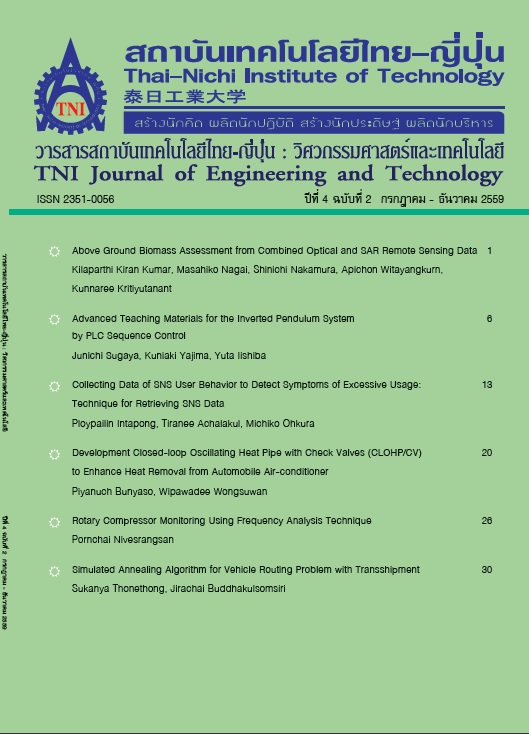Advanced Teaching Materials for the Inverted Pendulum System by PLC Sequence Control
Main Article Content
Abstract
Manufacture for beginners of the teaching materials by student’s proposals has been done fifth-year students’ practical training classes, in Dep. of Electronic Control Engineering, from 2010 to 2013. So we make this ideas develop some basic teaching materials of sequence control for international students and students in our college. Relay sequence control is the subject matter in these materials for beginners, because it is the foundation of sequence control. The purpose of manufacturing the materials is to enable students to understand the foundations of sequence circuits, such as logic circuit and self-hold circuit, using these teaching materials.Next, as an advanced step-up course of fundamental teaching materials, we developed new teaching materials whose subject is inverted-pendulum system. We selected the inverted-pendulum system, because it is unstable and it is possible to check the motion of pendulum visually. The objective of this inverted-pendulum system is to keep pendulum standing upright by using PLC-sequence control. The purpose of developing this teaching material is to enable students to understand sequence control. At present, we are testing the piecewise linear control for the inverted pendulum system, and we succeed to be able to keep it standing.
Article Details
Article Accepting Policy
The editorial board of Thai-Nichi Institute of Technology is pleased to receive articles from lecturers and experts in the fields of engineering and technology written in Thai or English. The academic work submitted for publication must not be published in any other publication before and must not be under consideration of other journal submissions. Therefore, those interested in participating in the dissemination of work and knowledge can submit their article to the editorial board for further submission to the screening committee to consider publishing in the journal. The articles that can be published include solely research articles. Interested persons can prepare their articles by reviewing recommendations for article authors.
Copyright infringement is solely the responsibility of the author(s) of the article. Articles that have been published must be screened and reviewed for quality from qualified experts approved by the editorial board.
The text that appears within each article published in this research journal is a personal opinion of each author, nothing related to Thai-Nichi Institute of Technology, and other faculty members in the institution in any way. Responsibilities and accuracy for the content of each article are owned by each author. If there is any mistake, each author will be responsible for his/her own article(s).
The editorial board reserves the right not to bring any content, views or comments of articles in the Journal of Thai-Nichi Institute of Technology to publish before receiving permission from the authorized author(s) in writing. The published work is the copyright of the Journal of Thai-Nichi Institute of Technology.
References
H. Okamoto, A relay and a sequencer. Amsterdam: OHM-Corp, 2005.
J. SUGAYA and K. YAJIMA, “Questionnaire Surveys of Students in Department of Electrical Control Engineering,” Research Report of SNCT, no. 36, pp. 53–58, 2006.
J. Sugaya and K. Yajima, “Development of Students’ Proposal-type Teaching Materials and their Practical Use Utilizing their Creativity,” in The 17th Technical College Symposium in Iwaki, Iwaki, 2010, p. 225.
S. ESAKI, H. KAWATSU, and M. TERAO, “Lecture of the Sequence Control Engineering Utilizing Self-Developed Experimental Device for Each Student,”Journal of Education the College of Technology, vol. 28, pp. 13–17, 2005.
Y. Iishiba, J. Sugaya, and K. Yajima, “The development of fundamental teaching materials and the inverted pendulum system as advanced sequence control,” presented at the 7th International Conference on InformationTechnology and Electrical Engineering (ICITEE), Chiang Mai, Thailand, 2015, pp. 156–161.
T. HASEGAWA and Y. MITE, “Educational Apparatus of Inverted Pendulum with Inertia Rotor,” Journal of Education the College of Technology, vol. 47, pp. 415–420, 2013.
H. Goto and K. Sagawa, “Control Characteristics Evaluation of Standing Posture during Swing Movement Using PID Control Law of One-link Inverted Pendulum Model,” Transactions of the Society of Instrument and Control Engineers, vol. 49, no. 12, pp. 1113–1120, 2013.
“Positioning control by controller in OMRON FA’s training service,” OMRON, 1999. [Online]. Available:https://www.fa.omron.co.jp/seminar/%20area/Detail%20/207.
Seminar education division: The manual for basic FA lecturers. Omron Corporation, 2009.
N. Fujiki, K. Kanzaki, and R. Matsuda, “Swinging-Up Motion and Upside-Down Standing of Pendulum with Inertia Rotor,” Transactions of the Japan Society of Mechanical Engineers Series C, vol. 68, no. 667, pp. 810– 816, 2002.
I. MORISHITA and T. UENO, Digital control engineering. Amsterdam: OHM Corp, 1987.


